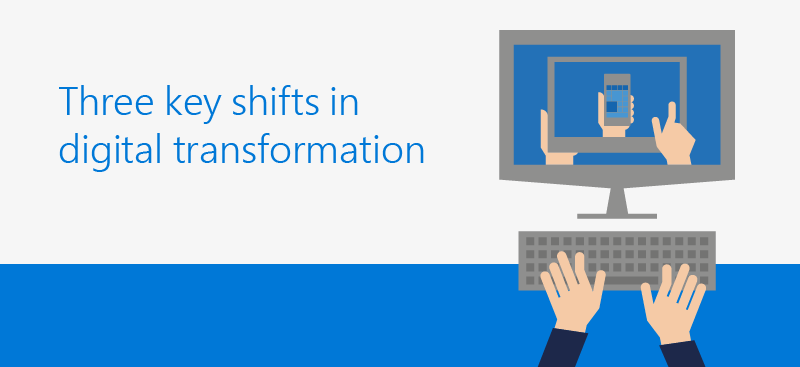Three key shifts in digital transformation

Digital transformation is a massive topic. And its importance feels impossible to escape. No wonder, then, that in five blog posts, it feels as though we've touched on just a few ways to use technology for change. Things like getting ready for the modern workplace. And the apps and devices customers will be looking for. And new ways to use data to make decisions.
These are, of course, the basics. But we've only just scratched the surface.
So let's go deeper. We'll start here, with three ways the cloud is changing how your customers work - and how you can work with them.
Future Decoded
Did you attend our Future Decoded event earlier this year? Then you've probably already heard this from Microsoft Vice President Jean Phillippe Courtois during the Vision keynote (if you missed it, you can catch up here). This was a chance for leaders from businesses large and small - your customers - to make sense of what it means to digitally transform. And Jean Phillippe shared a valuable insight: it's no longer enough to be mobile first; the cloud is behind three key shifts that exist on every level of your customers' businesses.
They are:
- Multi-device and multi-sense experiences.
- Artificial intelligence (AI).
- Serverless technologies.
Let's take a look at each in a little more detail.
Multi-device and multi-sense
There's always been a need to be able to multi-task at work. But what about the tools your customers use to complete those tasks? Multi-device and multi-sense experiences are a key symptom of digital transformation. And they're quite simple.
This is work that's done through uniquely human experiences - across multiple devices and multiple senses. This could be dictating notes by voice. Or annotating using ink. Or interacting in mixed reality. Or any number of other ways to work.
Artificial Intelligence
Speaking of being joined-up, the second key shift is about how you keep your customers informed - by making sure they have the information they need to do great work. AI via the cloud is infusing everything a company does. It's bringing intelligence to employees, and it's changing the way your customers work.
AI isn't just about omnichannel. It does a whole lot more for your customers. It helps them set their service apart by giving every customer experience a personal touch. It keeps things clear and makes sure knowledge is with the right person, in the right place, at the right time. And above all, it makes sure everybody - employees and customers alike - are on one journey.
Serverless technologies
The third key shift is the way your customers develop, deploy, and manage the technologies and information they rely on to succeed. It all comes together here, in a serverless environment. Here, customers get more done, faster, with the intelligent edge. It's dynamic. It's responsive. It's the heart of the business, and it connects everything.
It's in these ways the cloud can disrupt business and drive transformation. And you can see them at work already.
It's already happening
You can see multi-device and multi-sense transforming the way thyssenkrupp Elevator technicians do their day-to-day work. They use Skype and HoloLens, the mixed reality headset, to see the problem before they start a job. Then, once they reach the site, they have real-time access to technical information as they work. It's all hands-free, too, and has cut the average length of service calls by four times.
AI is making for a more cohesive customer journey at Dixons Carphone. Customers of the electronics brand can take to Facebook and chat with Cami. This "mildly geeky and quite confident" AI bot is built from the Microsoft Bot Framework and Microsoft Cognitive Services. Cami bridges the gap between channels - giving in-store employees a head start on how best to serve customers, based on the online chats they've had with Cami.
And BAFTA and Emmy award-winning studio Jellyfish Pictures has been able to run its accelerated apps using serverless technology, with Microsoft Azure N-Series. It's made the server more efficient and productive, cutting the time it takes to render special effects by five times. And there's no risk of over-provisioning server use. This is what we call the intelligent edge - using the data accumulated by every part of the business to inform and adjust the way its technology operates.
Jean Phillippe said it himself:
"This is an era where every company is becoming a digital business."
Thinking of moving into data and cloud solutions? We can help you help your customers in any one of these three shifting areas - and best of all, we can help you do it securely. That's what we'll be looking at in the next blog post. Check back next time to see how you can secure the modern workplace for your customers.